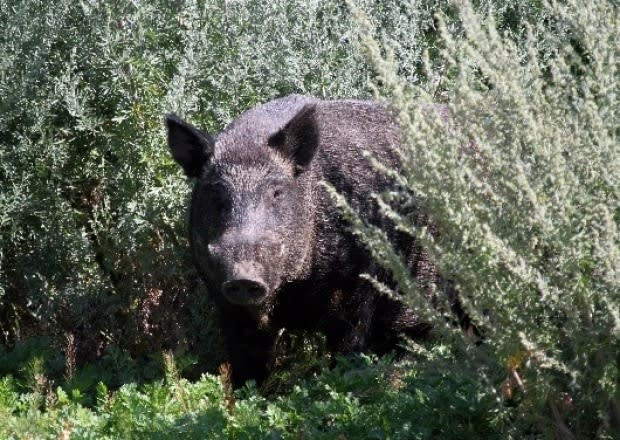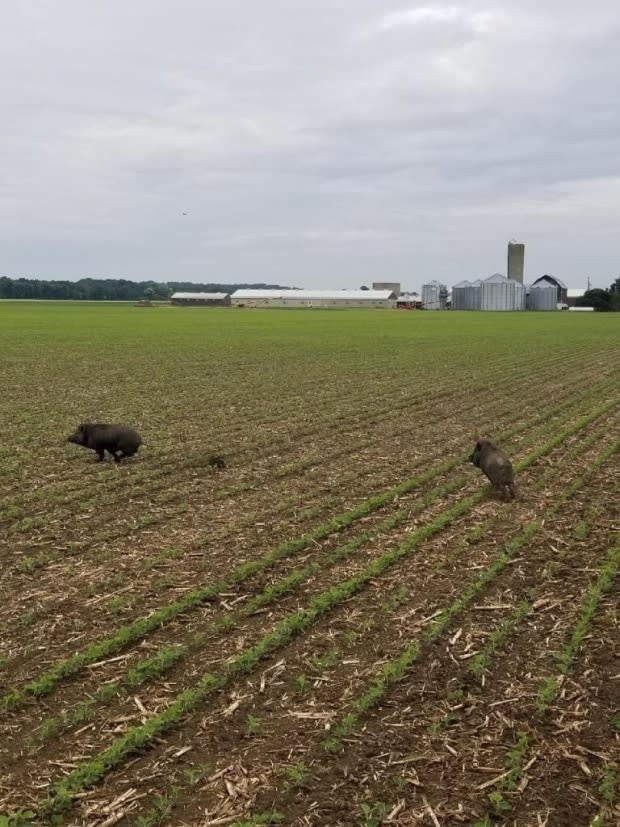Wild pigs 'an ecological train wreck' says prof, and Ontario needs to take action
They're massive, elusive and they'll eat virtually anything — even white-tailed deer.
Wild pig sightings have been reported across Ontario thanks to a tip line from the Ministry of Natural Resources and Forestry (MNRF), but one expert says simply monitoring them isn't enough. The province needs to act now.
"Much like a forest fire, if you wait, that fire becomes completely out of control," explained Ryan Brook, an associate professor at the University of Saskatchewan and director of the Canadian Wild Pig Research Project. "That's exactly where Ontario stands right now. If they don't get really aggressive really fast and have a action plan to find and remove these pigs very actively ... there's no question southern Ontario could support a million wild pigs."
Brook speaks from experience. About 20 years ago he says Saskatchewan was in a similar situation, with a relatively low number of pig sightings. But the professor says a decision to "bury our head in the sand" led to an explosion across the southern half of the province to the point pigs are "essentially out of control now."
MNRF spokesperson Jolanta Kowalski said there have been roughly 51 wild pig sightings across Ontario in recent years, stretching from Windsor to north of Algonquin Park.
A pair of wild pigs were spotted in Norfolk County last month, part of a recent surge in sightings Kowalski says the MNRF is experiencing thanks to its efforts to raise public awareness through social media.

The ministry is asking anyone who spots wild pigs to post a photo and description on the the iNaturalist Ontario Wild Pig Reporting webpage or to email wildpigs@ontario.ca.
"We're tracking sightings and once we've gathered the information then that will help us determine what next steps are," she explained.
The 'ideal invasive species'
But while he applauds the idea of a tip line as a good first step, Brook described Ontario's plan to stick to simply monitoring wild pigs as "laissez faire" and "insane," adding "That is exactly the wrong attitude."
The fact that the number of sightings is relatively low and no big herds have been reported are good signs, but that doesn't mean officials can sit back, says Brook. When it comes to wild pigs there's a very narrow window to take action.
"They expand so fast, there's huge reproduction rates, they're so smart, highly mobile, they have all the characteristics of an ideal invasive species," he explained.
Pigs can be slippery and hard to find in the wild, meaning the reports that are coming in could only reflect a sliver of the true population.
And as their numbers grow Brooks said they'll get into wetlands and remote river valleys, making them even more difficult to root out and requiring a huge amount of resources along with "millions and millions of dollars" to get a handle on.
The professor said in places like Texas, where pigs wreak havoc, people think "you're crazy if you don't drop everything" to focus on getting rid of them.
"Ontario has years, at best, to deal with this. Blink your eyes twice and they could have the same problem as Saskatchewan real fast."
Wild pig is a term used to describe the hybrid offspring of domestic swine and imported Eurasian wild boar, which were imported to Canada starting in the 1980s to diversify livestock production.
Some of those animals escaped from farms while other wild pigs are the descendants of domestic pigs that turned feral over generations.
'Super pigs' present a big problem
Brook says they're sometimes called "super pigs" because the crossbreeding in their backgrounds led to bigger animals and larger litters that allow them to thrive in the wild.
The largest wild pig he's heard of being handled in Saskatchewan was a hefty 638 lbs — but an animal in the 100 to 300 lbs range is more typical.
Wild pigs come in a range of appearances, too. Brook said some are jet black, grey or brown, while others are reddish, speckled or just plain old pink.
Regardless of how they look, the professor says all wild pigs present a problem.
"Anything that looks and acts like a pig that's not inside a fence, in my view, should be brought back inside a fence or euthanized immediately."
Kowalski said people in Ontario can legally "destroy" wild pigs if they're threatening their property or safety. The MNRF has not received any reports of wild pigs injuring people, but it advises residents to treat pigs like any other big, potentially dangerous animal and keep their distance.
"Is a large partially wild animal and they're heavy so … you would want to avoid them," she explained.

Brook says the the real threat from wild pigs is to things like the environment, agriculture and essentially everything else in their path.
That's because they will eat "virtually anything," including rooting up and destroying wetlands with their snouts, devouring crops, gobbling up amphibians, eggs and birds.
"They will eat white-tailed deer fawns and adults," Brook added. "They are often referred to, correctly, as an ecological train wreck. They are a disaster."

